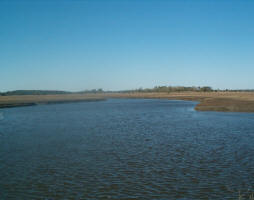Initiatives & Projects
 Mapping adaptation of barley to drought environments
Mapping adaptation of barley to drought environments
- Barley is
the pridominant crop in the driest land areas throughout the Mediterranean,
Being annually grown on 15 million ha. Grain Yields are particularly
affected by drought. The main objective of this proposal is to understand
the genetic and physiological dynamics and processes underlying adaptation
to drought.
- Novel materials will be developed and studied across a wide range of
Mediterranean drought-prone environments throughout Europe, North Africa and
West Asia. Contemporary genetics and plant physioloty tools will be used in
order to formulate a germplasm improvement strategy for water use efficiency
under rainfed Mediterranean environments.
| Project number | ICA3-CT-2002-10026 | ||
|---|---|---|---|
| Subject(s) | WATER DEMAND , no translation available | ||
| Acronym | MABDE | ||
| Geographical coverage | Morocco, Jordan, Italy, France, Algeria, Spain, Turkey, Syria | ||
| Budget (in €) | n/a | ||
| Programme | INCO MED (FP5) | ||
| Web site | http://www.iamz.ciheam.org/en/pages/contenidos/investigacion/info_detallada/trigoduro.htm | ||
| Objectives | - The
main objective of this proposal is to understand the genetic and
physiological dynamics and processes underlying (1) barley domestication and
adaptation to drought and (2) intensive barley breeding carried out in the
last century. Contemporary genetics and plant physiology tools will be used
in order to formulate a germplasm improvement strategy for water use
efficiency under rainfed Mediterranean environments. - Specific objectives: * Characterise and use a series of adaptation mechanisms to cope with drought: o Capture and identify naturally occurring variation for adaptation to arid Mediterranean environments at both the nuclear and cytoplasmic level. o Understand basic underlying physiological mechanisms of adaptation to drought, resulting in improved water use efficiency, over and above phenology. o Build on competencies in traditional mapping that take advantage of recombination in several backgrounds over many generations to identify and confirm candidate genomic regions associated with yield under drought. o Assess the role of candidate genes for adaptation emerging from genomic and physiological studies of model and related species. o Develop new integrative models for GE and QTLxE based on extensive multilocation yield data supplemented with genetical, physiological and environmental information. * Develop new genetic material to test and validate the role of nuclear and cytoplasmic genes in adaptation to drought. |
||
| Results | - The joint effort of the consortium will result in the generation of
extensive genotypic and phenotypical data sets to be used for genetic and
association studies in barley breeding for drought-prone areas throughout
the Mediterranean. This would be the single largest effort to address such a
critical issue, including more than 500 genotypes characterised with a
common set of molecular markers, and grown and studied across more than 20
experiments over sites and years. - This study will deliver new tools, targets and novel genetic materials for the study of adaptation of barley to drought. - Appropriate statistical methods for assessing marker-trait associations will be assessed for various types of response variables and marker systems. - Appropriate statistical methods for integrated (analytical) Genotype x Environment interaction analysis. - Target regions of the genome that can be used to search germplasm collections for novel but natural variants of potential benefit in breeding for drought-prone environments. - Formulation of a germplasm improvement strategy for water use efficiency under rainfed Mediterranean environments. |
||
| Period | [01/01/2003 - 31/12/2005] | ||
 you are not logged in
you are not logged in





